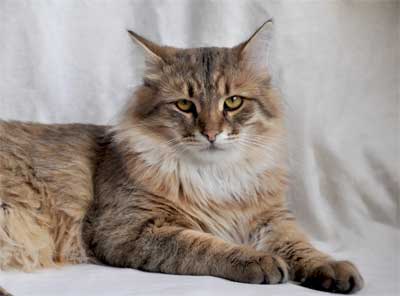About siberians
 According to some data, the ancestors of the Siberian cat appeared in Russia, close to the end of the 10th century. They were given as presents from the Byzantine monks, to children of Russian kings. After some time, they managed to get outside, and eventually bred with the already existing breed of Russian forest cats. Since then, the Siberian cat showed up in traditional Russian folklore. The first official mention of the Siberian cat was made in the 16th century, and by that time, they were discovered all over Russia. Sadly revolutions, wars, and economic and political instability, almost made the breed go extinct in the European part of Russia.
According to some data, the ancestors of the Siberian cat appeared in Russia, close to the end of the 10th century. They were given as presents from the Byzantine monks, to children of Russian kings. After some time, they managed to get outside, and eventually bred with the already existing breed of Russian forest cats. Since then, the Siberian cat showed up in traditional Russian folklore. The first official mention of the Siberian cat was made in the 16th century, and by that time, they were discovered all over Russia. Sadly revolutions, wars, and economic and political instability, almost made the breed go extinct in the European part of Russia.
Breeding Siberian cats was first emphasized in the 80’s in Moscow and St. Petersburg, Russia. The breed was described rather hazily: a big cat with thick, long fur, of any color other than white. Finding the cats that fit into this category wasn’t easy, because many cats fit the requirements, but almost none of them belonged to the Siberian breed.
Russian breeders finally found a few cats that fit into the categories, and didn’t belong to the Siamese, Persian, Maine Coon, and the Norwegian Forest cat breeds. The breeders, who wanted a fine breed of Siberians, looked for them in Siberia and the Eastern parts of Russia, where the best examples of the breed were present in the wild, and many households.
Some breeders wanted to make the traits of the Siberian more outstanding by breeding them with the Siamese and Persian breeds. Since then, Russia acquired a new breed of cats, The Neva Masquerade (Colour point), which is commonly mistaken with Siberian cats to this day. The Neva Masquerade has long fur, blue eyes, and the colour-point commonly seen in breeds derived from the Siamese breed. The colouration of the Neva Masquerade is different than the Siberian’s. The most common colouration of the Neva Masquerade is the Seal Point colouration, which encompasses a light body, with dark spots on the face, ears, feet, and tail. Sadly, the decorative additions, cost the Neva Masquerade its hypo-allergic nature.
The Siberian cat is a strong and powerfully built cat. The average cat weighs 6 kg (13 lbs.), and can reach 12 kg (26 lbs.). Such a large body requires large and muscular legs. The Siberian’s crowning features are the fur located between its paws, which it acquired from its forest and steppe ancestors, and its hypo-allergic fur. Its fur consists of a layer of thick outer fur, and a layer of very dense inner fur, which allows the cat to be comfortable in any weather.
Despite its rough appearance, it’s a very polite breed. If you respect it, its territory, and its friendship, then it will respect you in turn. Some Siberians can become lap-cats if they fully trust you. They are also born hunters, and will happily play with you. The more you talk to them, the more they talk back. The talkativity of this breed depends entirely on the emotional, verbal, and physical communication the owner displays. Siberians are very attached to their owners and their household. If you went away, they’d wait for you and miss you a lot.
This link contains the description of the standards of a Siberian cat based on The International Cat Association (TICA)